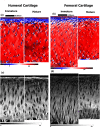Structural differences between immature and mature articular cartilage of rabbits by microscopic MRI and polarized light microscopy
- PMID: 34981507
- PMCID: PMC9119607
- DOI: 10.1111/joa.13620
Structural differences between immature and mature articular cartilage of rabbits by microscopic MRI and polarized light microscopy
Abstract
This study aimed to determine the structural features between immature and mature articular cartilage from the humeral and femoral joints of rabbits. Specimens of articular cartilage (n = 6 for immature tissue, n = 6 for mature tissue) that were still attached to the underlying bone from a humerus (shoulder joint) or femur (knee joint) were imaged using microscopic MRI (µMRI) and polarized light microscopy (PLM). Quantitative µMRI data with a pixel resolution of 11.7-13.2 µm revealed a number of differences between the immature and mature cartilage, including total thickness, and T2 and T1ρ relaxation values. Quantitative PLM data with a pixel resolution of 0.25-1 µm confirmed the µMRI results and revealed additional differences in cellular features between the tissues. The mature cartilage had a clearly defined tidemark, which was absent in the immature tissue. The ability to differentiate specific maturation-related cartilage characteristics could be beneficial to translational studies of degenerative diseases such as osteoarthritis.
Keywords: Collagen network; MRI relaxation anisotropy; articular cartilage; optical angle and retardation; polarized light microscopy; µMRI.
© 2022 Anatomical Society.
Figures







Similar articles
-
Quantitative µMRI and PLM study of rabbit humeral and femoral head cartilage at sub-10 µm resolutions.J Orthop Res. 2020 May;38(5):1052-1062. doi: 10.1002/jor.24547. Epub 2019 Dec 12. J Orthop Res. 2020. PMID: 31799697 Free PMC article.
-
Location-Specific Study of Young Rabbit Femoral Cartilage by Quantitative µMRI and Polarized Light Microscopy.Cartilage. 2022 Jan-Mar;13(1):19476035221085143. doi: 10.1177/19476035221085143. Cartilage. 2022. PMID: 35306861 Free PMC article.
-
Structural Morphology of Rabbit Patella and Suprapatella Cartilage by Microscopic MRI and Polarized Light Microscopy.Cartilage. 2021 Dec;13(2_suppl):356S-366S. doi: 10.1177/1947603521990882. Epub 2021 Feb 8. Cartilage. 2021. PMID: 33550833 Free PMC article.
-
Averaged and depth-dependent anisotropy of articular cartilage by microscopic imaging.Semin Arthritis Rheum. 2008 Apr;37(5):317-27. doi: 10.1016/j.semarthrit.2007.07.001. Epub 2007 Sep 21. Semin Arthritis Rheum. 2008. PMID: 17888496 Review.
-
MRI T2 and T1ρ relaxation in patients at risk for knee osteoarthritis: a systematic review and meta-analysis.BMC Musculoskelet Disord. 2019 May 1;20(1):182. doi: 10.1186/s12891-019-2547-7. BMC Musculoskelet Disord. 2019. PMID: 31039785 Free PMC article.
Cited by
-
Depth-Dependent Strain Model (1D) for Anisotropic Fibrils in Articular Cartilage.Materials (Basel). 2024 Jan 1;17(1):238. doi: 10.3390/ma17010238. Materials (Basel). 2024. PMID: 38204091 Free PMC article.
-
Characteristics of distal femoral articular cartilage in 6 weeks posttraumatic osteoarthritis by a subcritical impact.J Orthop Res. 2024 Apr;42(4):717-728. doi: 10.1002/jor.25721. Epub 2023 Nov 7. J Orthop Res. 2024. PMID: 37874329 Free PMC article.
-
Assessment of articular cartilage degradation in response to an impact injury using µMRI.Connect Tissue Res. 2024 Mar;65(2):146-160. doi: 10.1080/03008207.2024.2319050. Epub 2024 Feb 28. Connect Tissue Res. 2024. PMID: 38415672 Free PMC article.
References
-
- Alhadlaq, H.A. , Xia, Y. , Hansen, F.M. , Les, C.M. & Lust, G. (2007) Morphological changes in articular cartilage due to static compression: Polarized light microscopy study. Connective Tissue Research, 48(2), 76–84. - PubMed
-
- Carballo, C.B. , Nakagawa, Y. , Sekiya, I. & Rodeo, S.A. (2017) Basic science of articular cartilage. Clinics in Sports Medicine, 36, 413–425. - PubMed
-
- Flandry, F. & Hommel, G. (2011) Normal anatomy and biomechanics of the knee. Sports Medicine and Arthroscopy Review, 19(2), 82–92. - PubMed
Publication types
MeSH terms
Grants and funding
LinkOut - more resources
Full Text Sources
Medical

